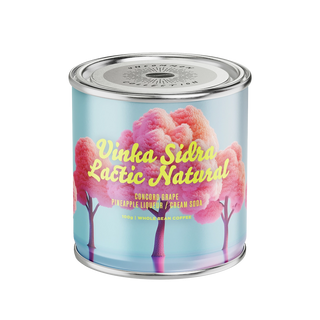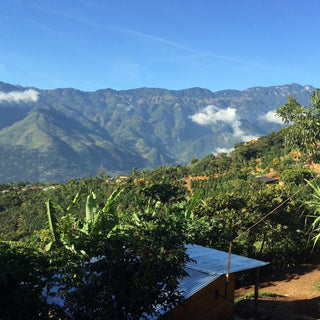- Filter
Vinka Sidra Lactic Natural
CONCORD GRAPE | PINEAPPLE LIQUEUR | CREAM SODA
*Roast Date: July 28th*
This is a funky one you won’t want to miss. It’s a Sidra that’s gone through meticulous fermentation. Maria Fernanda “Mafer” Tapia and her husband Carlos are microbiologists turned coffee farmers. They have been producing coffee for five years, and this is their second harvest. Alright, before I get geeky, let me just say this is a damn good anaerobic coffee. Why? Now you gotta read.
The coffee cherries were carefully harvested at their peak ripeness and hand-selected to ensure uniformity and quality. Next, a saline solution was prepared, and the cherries were submerged in an airtight container. This saline medium created a controlled anaerobic environment that encouraged the development of native lactic acid bacteria from their terroir, while limiting the growth of yeasts and other unwanted microorganisms. The fermentation process was closely monitored and maintained until it reached a pH of 3.7, at which point it was stopped by thermal shock with cold spring water. The coffee was then dried for five days in a raised bed, and the rest of the drying in a dark room. This kind of immaculate processing is what separates Mafer and Carlos from most coffee producers.
Adding product to your cart


MICROBIOLOGISTS KNOW HOW TO FERMENT!
Every once in a while I experience something so unexpected that I find it hard to believe and I begin to change a preconceived notion. I find this self development one of the coolest parts of being a coffee buyer. Two years ago, I experienced it with Maria Fernanda and Carlos’ coffee, a natural processed Sidra from their farm: Vinka.
OK, so my preconceived notion is that the first harvest of any coffee is going to taste average - it will give me a hint of what it’s going to be, but the plant needs 2, 3, 4 harvests to really, truly, impress. Well, this year, I tasted their first harvest of Sidra and it blew my mind. Let me just clarify one thing - the coffee underwent very heavy anaerobic natural processing, so this definitely helped the coffee reach its super high level, but nevertheless, I have never tasted a first harvest that remotely resembles the intensity of flavour of this one. It goes to show the power of controlled coffee processing!
The coffee itself was a Sidra that was planted in 2020 in their farm in Vilcabamba, near the municipality of Loja in the south of Ecuador. The farm sits at an elevation of 1660m and the highlight of the farm is the amount of native trees that are planted in and amongst the coffee. This is something that Maria Fernanda and Carlos are super passionate about - biodiversity, shade, creating soils that are rich in microorganisms and provide natural food for the coffee trees.
Maria Fernanda and Carlos are both biology majors who like to do a lot of research, so the coffee farm is their research haven. From biodiversity and soil health to microbiology in the coffee processing, they hope to study and eventually share many of their findings with their local community. Maria Fernanda and Carlos’s goal is to become leaders in sustainable and science driven coffee production. I love this simple goal that is so crazy full of challenges. They’re passionate about making an impact on their community, learn, share knowledge and continue to find ways to produce coffee while creating symbiosis with the environment.
– Sebastian


